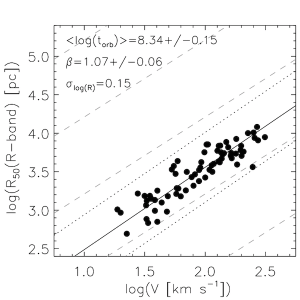Blog
The Wheel of Time
15 March 2018
 Hubble/Suburu
Hubble/SuburuThe universe moves like clockwork. Their motions can be described by elegant gravitational equations, which trace the motions of everything from planets to galaxies.
The gravitational attraction between any two bodies is stronger when they are closer together, a property known as the inverse square law. As a result, objects orbit each other more quickly when they are close together. The planet Mercury orbits the Sun once every 88 days, while distant Neptune takes 165 years.
Galaxies don’t follow this relation. Most of the visible matter in a galaxy is concentrated at its center, just like our solar system. So you would expect that stars close to the center of a galaxy would move much more quickly than those on the outer edge. But it turns out that both central and edge stars move at about the same speed. This is due to the fact that galaxies are largely comprised of dark matter.
 Meurer, et al.
Meurer, et al.Even with dark matter, galaxies vary widely in mass. So one would still expect stars in dense and massive galaxies to orbit more quickly than stars in more diffuse galaxies. But it turns out that isn’t the case.1 New observations of galaxies found that regardless of a galaxy’s size, the stars on the outer edge of the galaxy take about a billion years to orbit the galaxy once. The relation holds for small dwarf galaxies just as well as it holds for massive spiral galaxies. We aren’t entirely sure why. Some simple models of galactic evolution allow for such a relation, but we will need more data to pin down the exact mechanism.
This isn’t the first time we’ve found a relation among galaxies without fully understanding the underlying cause. The most famous one is the Tully-Fisher relation, which connects rotation speed to the overall brightness of a galaxy. But even without a known mechanism, this relation could be quite useful. By measuring the speed of stars on the edge of a galaxy, we can easily pin down its overall size. This can be difficult to do with distant galaxies.
Meurer, Gerhardt R., et al. “Cosmic clocks: a tight radius–velocity relationship for H i-selected galaxies.” Monthly Notices of the Royal Astronomical Society 476.2 (2018): 1624-1636. DOI: 10.1093/mnras/sty275 ↩︎